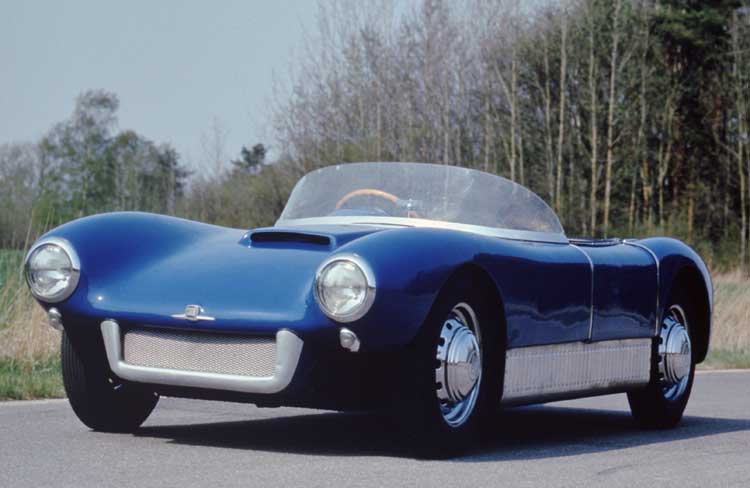Saab Sonett
Lance Cole recalls the Saab Sonett, a poem of a sporty coupé that never quite made it to epic status

If you think the Saab Sonett is a late 1960s-to-1970s fibreglass-bodied coupé that embodies a forgotten, sportier side of Saab, think again. The Sonett actually started life in 1954 as one of the most revolutionary and advanced examples of post-war car design. It was a uniquely constructed open-topped two-seater that looked like a cross between an MG and an Alfa Romeo. Yet it was years before this stillborn wild child of a Scandinavian design group actually became the Saab Sonett.
In Swedish "Sa natt" means "How nice", which is what the legendary Swedish car-designer Sixten Sason is supposed to have said when his first body for the car was finished and mounted on its chassis with a smoky two-stroke engine.
Unlike its 1950s contemporaries, the original Sonett did not have a tubular steel fabricated body nor a floppy monocoque with more shake than a jelly. Instead, the Sonett boasted a unique body made from a blend of aluminium sheets and plastic moulded panels weighing only 70kg, that were bonded together to form a stiff, aviation-style, stressed hull. It would be years later that Colin Chapman created the original Lotus Elite's fibreglass unitary monocoque body, and decades before a car-maker made an aluminium car.
The original Sonett 1 was dreamed up by Rolf Mellde - Saab's suspension and engineering genius. Along with Sason, the Saab team included Lars Olov Olsson and Olle Lindkvist and Gotta Svensson. With them, Mellde created an alternative Saab to the firm's teardrop-shaped 92-93 range of steel-bodied family saloons. They cooked the car up in a barn at Asaka, half an hour's drive from Trollhattan, mostly in their own time. Saab management let the geniuses get on with it, without actually being officially involved. On seeing the Sonett, Saab whisked it off to become an official motor-show prototype of their new sports car: the ultra-light Sonett could do 130mph from 57bhp.
Despite various plans and projections, and despite a great reception from press and public - including in America - Saab's exquisite little car never made it to production life: At one stage Jensen were to build the bodies in the UK, but Saab faltered. Only 6 were made before the idea died.
But, in 1966 the idea of a sporty Saab coupé came to the fore again. By this time Sason had designed another pretty, fibreglass, Italianate coupé - the Catherina - that showed the world a lift-out, stowable, targa-style roof for the first time. Saab decided to push a coupé into production, yet the Catherina design was not chosen: instead the work of Bjorn Karlstrom with another Swedish aircraft company named Malmo Flygindustri was taken up by Saab's management. Karlstom's car was called the MFI 13. Given that it had a plywood rear floor, the "MFI" tag seems apposite, but it became the Sonett II.
Premiered at the 1966 Geneva motor show, the two-stroke-engined car had a steel chassis with conventional tubular reinforcements. Draped over the top was a delicate looking fibreglass shell with an early use of a large, wraparound, glazed rear window. From 1966 through to 1970 the pert little Sonett II evolved with typical Saab product-development. In 1968 it gained the V4 engine from the Saab 96.But, by 1970 the car was looking odd, with scoops, engine bulges and stylistic fiddlings: only 4,000 were sold.
So Saab commissioned a revised Sonett. This Sonett III was a long-nosed coupé with overtones of Italian exotica - as penned by the Milanese designer Sergio Coggiola. Saab did however get its own in-house artist Gunnar Sjogren to style much of the new Sonett's plastic body-details.
The spec included moulded seat-pans, and trim items from the Saab 96 and 99 ranges - including the alloy wheels from the 99EMS. The Triumph-style flip-top bonnet of the Sonett II had gone, and, despite the addition of the new Saab corporate grille and US-style bumpers, the Sonett had an elegant style and sold well - notably in the eastern seaboard states of the USA. The Sonett III survived until 1974, with the final cars mostly being sold in racing colours; many remain in use and for sale at cheap prices in California today. In the USA Sonetts scooped up many sports-car racing wins in the 1980s, with Jack Lawrence and his tuned V4 injection Sonett proving that the it might not have rallied, but it could race. A one-off soft-top was also created.
The Sonetts also had a strong following in Britain and Europe. Many enthusiasts dream of another Sonett - a sports coupé that would revitalise the company, yet most know that it would, in light of recent dictates from Saab's owner, end up being a General Motors marketing lash-up.
Subscribe to Independent Premium to bookmark this article
Want to bookmark your favourite articles and stories to read or reference later? Start your Independent Premium subscription today.

Join our commenting forum
Join thought-provoking conversations, follow other Independent readers and see their replies